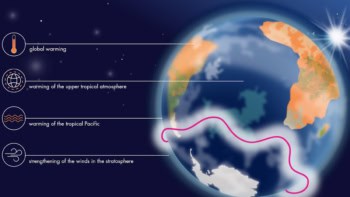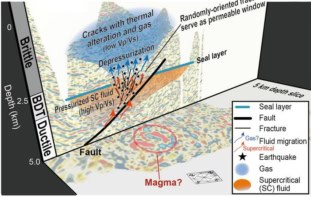
Low-level clouds are involved in a positive feedback mechanism that could exacerbate global warming — according to a study of cloud and temperature records from the north-eastern Pacific Ocean. Scientists in the US have found that low-level cloud cover decreases when the sea surface gets warmer. Fewer clouds mean that more sunlight reaches Earth’s surface, leading to further warming.
Understanding how climate change is affected by low-level clouds is one of the key challenges facing climate scientists. Such clouds are known to have a net cooling effect — so if rising temperatures lead to more low-level clouds, this negative feedback mechanism could mitigate global warming. But if higher temperatures lead to fewer clouds, the feedback is positive and global warming could be enhanced.
Observational data linking low-level cloud cover and temperature are scarce and the formation and dissipation of clouds is notoriously difficult to model and integrate into global climate simulations.
Now, Amy Clement and Robert Burgman of the University of Miami and Joel Norris of the University of California-San Diego have done a statistical analysis of 55 years of cloud cover and temperature observations for the north-eastern Pacific Ocean. Their study provides the best evidence yet that low-level cloud cover decreases as temperature increases — that the feedback mechanism is positive.
Wrong type of clouds
When temperatures are higher, Clement believes that water rises higher into the atmosphere to create upper-level clouds at the expense of low-level clouds. These higher clouds, however, have a net greenhouse effect and therefore their creation could further boost the positive feedback.
The team compared their findings with feedback predictions made by 18 leading climate models. Only two models predicted a positive feedback and one of these — HadGEM1 from the UK’s Hadley Centre — was particularly good at reproducing the observed relationships between cloud cover, atmospheric circulation and temperature.
Clement believes HadGEM1 performed well because Hadley scientists have “spent a lot of time looking at the lower kilometre of the atmosphere”.
Clement told physicsworld.com that the strength of the positive feedback is in the upper range of that predicted by the Intergovernmental Panel on Climate Change (IPCC). An important consequence of this is that global warming could be worse than many scientists had anticipated. Indeed, HadGEM1 predicts a 4.4° average global temperature increase when carbon dioxide is doubled — compared to the 3.1° median of the 18 models.
A perfect ‘laboratory’
The team focused on the north-eastern Pacific Ocean because the average temperature in the region fluctuates significantly on a ten-year timescale — and because comprehensive cloud-cover observations have been made over the years by satellites as well as by the many ships that sail through the region. This makes it a perfect “laboratory” for studying the relationship between clouds and temperature.
Clement says that it is possible that the observed feedback is specific to the north-eastern Pacific and may be different in other parts of the world where there is significant low-level cloud cover. To test this, the team is now doing a similar study of data from the south-eastern Pacific.
Matthew Collins of the Hadley Centre said that the result sheds significant light on the role of clouds and will be used to evaluate and improve the performance of climate models. However, he cautions that cloud feedback is only part of the picture — and the type of clouds studied by Clement and colleagues are significant only in certain parts of the globe.
This research appears in the latest edition of Science.



